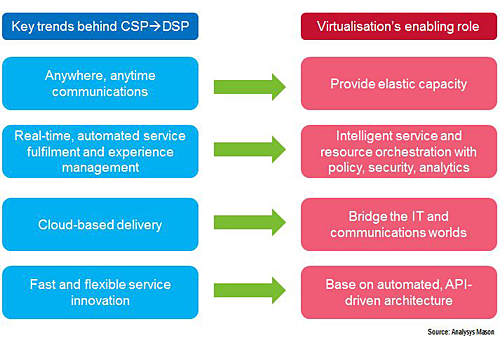To be full participants in the digital economy (DE), which Analysys Mason defines as “all socio-economic activity, mediated by software, enabled by telecoms networks, leveraging big data”, telecoms players must rethink networking, innovate more rapidly and radically than in the past and embrace a broader view of their customers and competitors.
Communications service providers (CSPs) must build mobile and fixed networks that enable much more agility in developing, deploying and managing dynamic and personalised services. At the same time, the pressure for these networks to be much more cost-efficient will remain. To further complicate the picture, to provide the most utility to customers, communications networks must support a wide array of third-party DE applications. Finally, network and network operations support suppliers must allow more open, multi-vendor approaches and cloud-based delivery models.
Virtualisation is a new and important tool for building tomorrow’s more scalable, flexible and dynamic software-controlled networking (SCN) foundation, whether that network be a 5G mobile broadband network, a fixed broadband network, a data centre network or the IP/optical wide network that connects these assets to each other and to enterprise customers.
Key considerations when rethinking networks
What it means for CSPs
With billions invested in physical network assets and employees trained to build and maintain them, a CSP cannot simply start over with a clean slate; it must develop a plan and evolve over a decade or longer to that plan. CSPs must retrain or hire employees; test proofs of concept (PoC); develop new business models; reframe content and applications providers (aka OTTs) as potential customers, not competitors; partner and negotiate with vendors; and implement new network deployment and service delivery strategies. In short, CSPs must create business plans that reconsider their entire operation…all while continuing to support today’s customers and services and maintaining high quality and reliability.
A CSP that embarks on a plan to reinvent itself and expand from its strength of providing communications services to become a digital service providers (DSP, see Figure 1) must have a clear sense of where it is today as well as where it wants to go and when it wants to get there.
As far as using virtualisation as a tool for tomorrow’s DSP future, it is very early in CSPs’ journey; true transformation takes time and maturity both in technology and in business planning and implementation, and, as noted, organisational change is a critical component of making the shift. Every operator will have a different starting point and different business goals, so each one’s path to becoming a DSP will be different; one size will not fit all. It is important that each CSP have a realistic picture of their starting point as benchmarked against other CSPs in their market.
Working together, Nokia and Analysys Mason have developed a “Telco Cloud Index” that seeks to benchmark individual carriers as they traverse the technology and business maturity matrix to true transformation. Initial results from our benchmarking study are very encouraging; CSP participants have found the information very useful as an input to their strategic network and business evolution efforts.
What it means for vendors
Vendors who want to be partners to their CSP customers and help them make the DSP transition must also transform. They must revamp their entire development process; learn to take advantage of open source software; create or join partner ecosystems to streamline product development and distribution; restructure professional services offerings and partnerships; reconsider pricing models; and anticipate new competitive threats. Our market research highlights many examples where rival companies are consolidating and start-ups or specialist vendors in adjacent markets are expanding to take advantage of the business opportunities afforded by this new wave of network upgrades.

Further reading:
Leveraging next-generation and virtual networks
SDN & OpenFlow World Congress 2015: first-movers’ build or buy dilemma in an immature
Software-controlled networking: worldwide forecast 2015–2019
vNGN-OSS: an architectural framework for virtual network management and orchestration
The author of this blog is Dana Cooperson, head of networks-focused software systems research at Analysys Mason
Dana is the research director for Analysys Mason’s network-focused software research programmes. Her area of expertise is intelligent fixed and mobile network infrastructure. Her goal is to help customers strengthen their link in the communications value chain while evolving their business operations to benefit from, rather than be threatened by, shifts in the market. The key network infrastructure trends Dana focuses on include the integration of communications and IT assets and the drive towards software-controlled, virtual networking.






